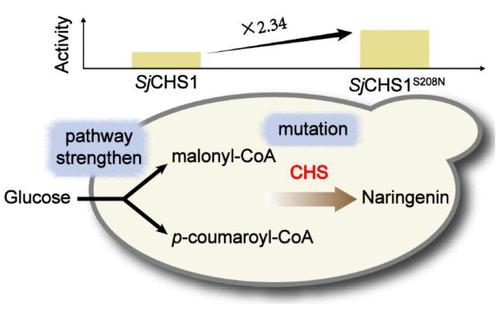当前位置:
X-MOL 学术
›
ACS Synth. Biol.
›
论文详情
Our official English website, www.x-mol.net, welcomes your
feedback! (Note: you will need to create a separate account there.)
Improvement of Chalcone Synthase Activity and High-Efficiency Fermentative Production of (2S)-Naringenin via In Vivo Biosensor-Guided Directed Evolution
ACS Synthetic Biology ( IF 3.7 ) Pub Date : 2024-04-25 , DOI: 10.1021/acssynbio.3c00570 Yingjia Tong 1, 2, 3 , Ning Li 2, 3 , Shenghu Zhou 2, 3 , Liang Zhang 2, 3 , Sha Xu 2 , Jingwen Zhou 2, 3, 4, 5
ACS Synthetic Biology ( IF 3.7 ) Pub Date : 2024-04-25 , DOI: 10.1021/acssynbio.3c00570 Yingjia Tong 1, 2, 3 , Ning Li 2, 3 , Shenghu Zhou 2, 3 , Liang Zhang 2, 3 , Sha Xu 2 , Jingwen Zhou 2, 3, 4, 5
Affiliation

|
Chalcone synthase (CHS) catalyzes the rate-limiting step of (2S)-naringenin (the essential flavonoid skeleton) biosynthesis. Improving the activity of the CHS by protein engineering enhances (2S)-naringenin production by microbial fermentation and can facilitate the production of valuable flavonoids. A (2S)-naringenin biosensor based on the TtgR operon was constructed in Escherichia coli and its detection range was expanded by promoter optimization to 0–300 mg/L, the widest range for (2S)-naringenin reported. The high-throughput screening scheme for CHS was established based on this biosensor. A mutant, SjCHS1S208N with a 2.34-fold increase in catalytic activity, was discovered by directed evolution and saturation mutagenesis. A pathway for de novo biosynthesis of (2S)-naringenin by SjCHS1S208N was constructed in Saccharomyces cerevisiae, combined with CHS precursor pathway optimization, increasing the (2S)-naringenin titer by 65.34% compared with the original strain. Fed-batch fermentation increased the titer of (2S)-naringenin to 2513 ± 105 mg/L, the highest reported so far. These findings will facilitate efficient flavonoid biosynthesis and further modification of the CHS in the future.
中文翻译:

通过体内生物传感器引导的定向进化提高查耳酮合酶活性并高效发酵生产 (2S)-柚皮素
查耳酮合酶 (CHS) 催化 (2 S )-柚皮素(必需的类黄酮骨架)生物合成的限速步骤。通过蛋白质工程提高 CHS 的活性,可以通过微生物发酵增强 ( 2S )-柚皮素的生产,并可以促进有价值的黄酮类化合物的生产。在大肠杆菌中构建了基于TtgR操纵子的( 2S )-柚皮素生物传感器,并通过启动子优化将其检测范围扩大到0-300mg/L,这是报道的( 2S )-柚皮素的最宽范围。基于该生物传感器建立了CHS高通量筛选方案。通过定向进化和饱和诱变发现了一个突变体Sj CHS1 S208N ,其催化活性提高了2.34倍。在酿酒酵母中构建了Sj CHS1 S208N从头生物合成( 2S )-柚皮素的途径,结合CHS前体途径优化,( 2S )-柚皮素效价较原菌株提高了65.34%。补料分批发酵将 ( 2S )-柚皮素的滴度提高至 2513 ± 105 mg/L,为迄今为止报道的最高值。这些发现将有助于未来有效的类黄酮生物合成和 CHS 的进一步修饰。
更新日期:2024-04-25
中文翻译:

通过体内生物传感器引导的定向进化提高查耳酮合酶活性并高效发酵生产 (2S)-柚皮素
查耳酮合酶 (CHS) 催化 (2 S )-柚皮素(必需的类黄酮骨架)生物合成的限速步骤。通过蛋白质工程提高 CHS 的活性,可以通过微生物发酵增强 ( 2S )-柚皮素的生产,并可以促进有价值的黄酮类化合物的生产。在大肠杆菌中构建了基于TtgR操纵子的( 2S )-柚皮素生物传感器,并通过启动子优化将其检测范围扩大到0-300mg/L,这是报道的( 2S )-柚皮素的最宽范围。基于该生物传感器建立了CHS高通量筛选方案。通过定向进化和饱和诱变发现了一个突变体Sj CHS1 S208N ,其催化活性提高了2.34倍。在酿酒酵母中构建了Sj CHS1 S208N从头生物合成( 2S )-柚皮素的途径,结合CHS前体途径优化,( 2S )-柚皮素效价较原菌株提高了65.34%。补料分批发酵将 ( 2S )-柚皮素的滴度提高至 2513 ± 105 mg/L,为迄今为止报道的最高值。这些发现将有助于未来有效的类黄酮生物合成和 CHS 的进一步修饰。


















































 京公网安备 11010802027423号
京公网安备 11010802027423号